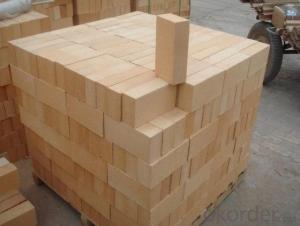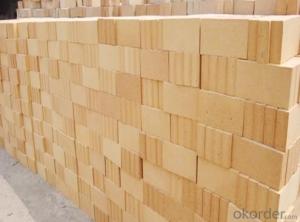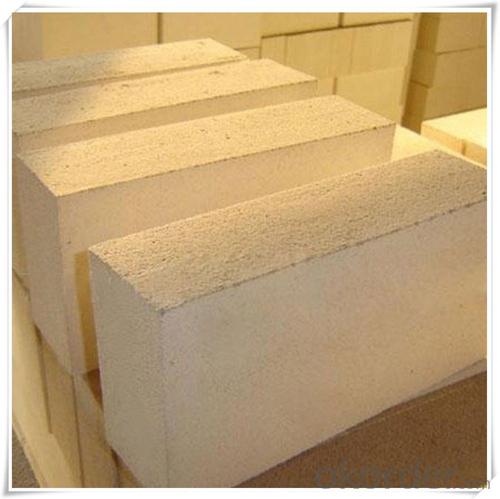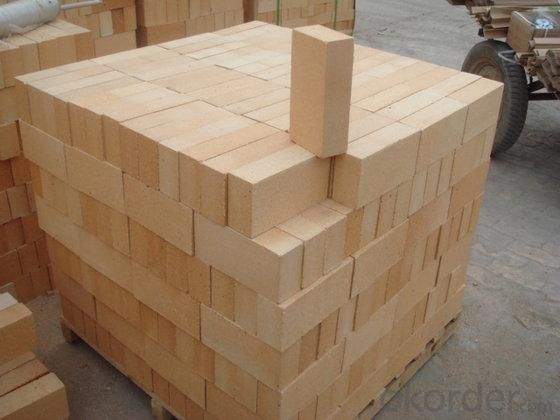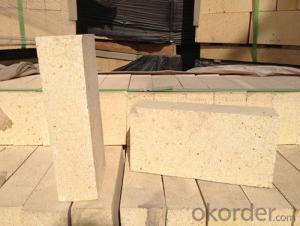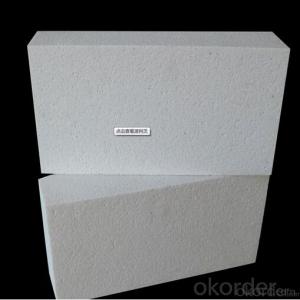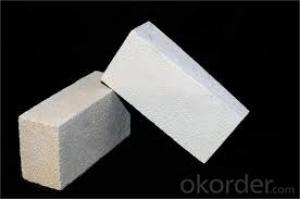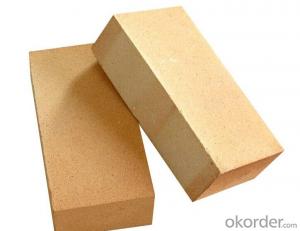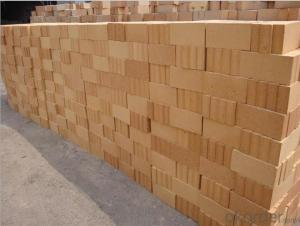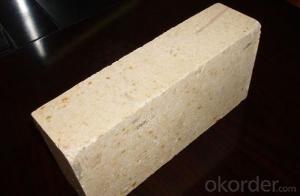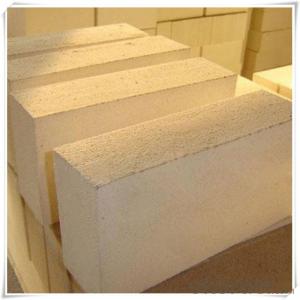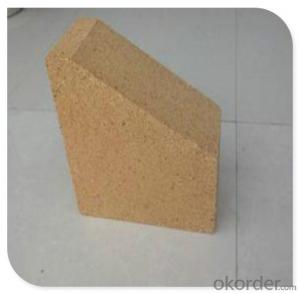High Alumina Refractory Brick Cutting Machine
- Loading Port:
- China main port
- Payment Terms:
- TT OR LC
- Min Order Qty:
- 30 m.t.
- Supply Capability:
- 2000 m.t./month
OKorder Service Pledge
OKorder Financial Service
You Might Also Like
CNBM conforms strictly to the requirements of ISO 9000 quality control system during the production. MSDS is also available if you want. The thermal insulation fire clay brick meet with the requirements of ASTM & JIS standards. So pls stay cool with our quality.
Insulating Fire Brick Technical index
Product No. | IFB70 | IFB60 | IFB50 | IFB40 |
Al2O3 | 68%-72% | 58%-62% | 48%-52% | 38%-40% |
Refractoriness (°C ) | ≥1790 | ≥1790 | ≥1790 | ≥1790 |
Bulk density (g/cm3) | 2.50-2.60 | 2.35-2.45 | 2.20-2.30 | 2.10-2.20 |
Apparent porosity (%) | 22 | 19-22 | 17-20 | 17-20 |
Cold Crushing strength (kg) | 480-510 | 450-480 | 430-450 | 390-430 |
Application
Insulating Fire Brick are used for the lining of converter, alternating current arc furnace, direct Current arc furnace and the ladle slag line, etc.
Equipment
1 unit of Ceramic Abrasive (SG Abrasive) pilot production line
2 units of Compact grain Abrasive pilot production lines
1 unit of high-end coated abrasives (abrasive cloth) production line
Company Advantage
(1)Long Insulating Fire Brick manufacture history: 25 years manufacturer
(2)Advanced equipment
(3)Diversification of production standards: ISO ANSI FEPA JIS ASTM
(4)Flexible payment: T/T L/C D/P D/A
(5)Professional marketing team and after-sale service
(6)Free sample
FAQs
Q1 |
What’s the transport method? |
A1 | FCL delivery goods with wooden pallet or wooden case by sea; If LCL delivery, must with wooden case; Sometimes need open top, flat rack or bulk cargo. |
Q2 |
What’s the required payment term? |
A2 | Generally 30% TT as the prepayment, 70% TT before delivery. If need, 100% Irrevocable Letter of Credit or negotiation. |
Q3 |
Which country are our products exported to? |
A3 | Apart from entire Chinese market, the US, Russia, Japan, Korea, Australia and some Southeast Asian Nations. |
- Q: Can insulating fire bricks be used in high-temperature insulation boards?
- Yes, insulating fire bricks can be used in high-temperature insulation boards. Insulating fire bricks are designed to withstand high temperatures and provide excellent thermal insulation. They are commonly used in applications that require insulation at elevated temperatures, such as kilns, furnaces, and fireplaces. When used in high-temperature insulation boards, insulating fire bricks can help to minimize heat loss and maintain a stable temperature. However, it is important to consider the specific requirements of the application and ensure that the insulating fire bricks are compatible with the insulation board material and installation method.
- Q: What is the price of refractory bricks?
- The refractory insulating brick generally refers to light brick, normal furnace lining are using this brick kiln will not increase the weight, and good heat insulation effect and ordinary insulating brick production are made of clay, high alumina high strength low iron bead brick, mullite, high aluminum light insulating firebrick, diatomite insulating refractory brick, the use of light heat insulation brick can increase the use of the area, at the same time, good insulation effect, in the hot summer, the temperature of the furnace using solid clay brick and low 2-3 ~ C, reduce the power consumption. The construction is superior, the light insulating brick has good machinability, and the construction is convenient and simple, and the labor intensity can be reduced, the construction efficiency can be improved, and the construction period can be shortened. The price is determined by the choice of material and volume density, from several hundred to 5000 yuan, mainly with the choice of material
- Q: What is the porosity of insulating fire bricks?
- Insulating fire bricks possess a porosity that pertains to the quantity of vacant areas or gaps present in the material. These bricks are engineered to possess a considerable porosity, typically falling within the range of 50% to 80%. This notable porosity facilitates exceptional thermal insulation properties by entraping air or other insulating gases within the gaps. The air pockets function as obstacles for heat transfer, thereby diminishing the conduction of thermal energy through the bricks. Consequently, insulating fire bricks prove highly efficient in upholding elevated temperatures within industrial furnaces, kilns, or other high-temperature uses while minimizing heat loss. The specific porosity of insulating fire bricks can differ based on the manufacturing process and the desired level of insulation necessitated for a specific application.
- Q: Are insulating fire bricks suitable for use in high-temperature chimneys?
- Yes, insulating fire bricks are suitable for use in high-temperature chimneys. These bricks are specifically designed to withstand extreme temperatures and provide excellent insulation properties. They have a high melting point and low thermal conductivity, which allows them to effectively retain heat and prevent it from escaping through the chimney walls. This helps in maintaining a high temperature inside the chimney, which is crucial for efficient combustion and proper functioning of the chimney. Additionally, insulating fire bricks are lightweight and durable, making them an ideal choice for constructing chimneys that are exposed to high temperatures.
- Q: Do insulating fire bricks expand and contract with temperature changes?
- Yes, insulating fire bricks do expand and contract with temperature changes.
- Q: Can insulating fire bricks be used in high-temperature kilns and furnaces?
- Yes, insulating fire bricks can be used in high-temperature kilns and furnaces. Insulating fire bricks are specially designed to withstand extreme heat and provide excellent insulation properties. They are made from lightweight refractory materials, such as clay and silica, which have high melting points and low thermal conductivity. These bricks can effectively retain heat, reducing energy loss and improving the efficiency of the kiln or furnace. Additionally, insulating fire bricks have good resistance to thermal shock, meaning they can handle rapid temperature changes without cracking or breaking. This makes them suitable for use in high-temperature applications where the kiln or furnace may go through frequent heating and cooling cycles. Overall, insulating fire bricks are an ideal choice for insulating and protecting high-temperature kilns and furnaces.
- Q: Can insulating fire bricks be used for insulation in autoclaves?
- Yes, insulating fire bricks can be used for insulation in autoclaves. Insulating fire bricks are designed to have low thermal conductivity, which means they can effectively retain heat and withstand high temperatures. Autoclaves require insulation to maintain a consistent temperature and pressure, and insulating fire bricks can provide excellent insulation properties in these demanding conditions. Additionally, their high strength and durability make them suitable for withstanding the intense heat and pressure cycles that occur in autoclaves. Overall, insulating fire bricks are a reliable and effective choice for insulating autoclaves.
- Q: Are there any safety precautions to consider when using insulating fire bricks?
- Yes, there are safety precautions to consider when using insulating fire bricks. Firstly, it is important to wear appropriate personal protective equipment, such as gloves and safety goggles, to protect against potential injuries. Additionally, due to the high temperatures involved, it is crucial to handle the bricks with care to avoid burns or related accidents. Adequate ventilation should be ensured to prevent the buildup of harmful gases and fumes. Lastly, it is essential to follow the manufacturer's instructions and guidelines for proper installation and usage to minimize any potential risks.
- Q: Can insulating fire bricks be used in kilns or furnaces?
- Yes, insulating fire bricks can be used in kilns or furnaces. Insulating fire bricks are designed specifically to withstand high temperatures and thermal shock, making them ideal for use in kilns or furnaces. They have excellent insulating properties, which help to conserve heat and improve energy efficiency. Additionally, insulating fire bricks are lightweight and easy to install, making them a popular choice for lining the walls and floors of kilns or furnaces. Overall, insulating fire bricks are a reliable and effective solution for maintaining high temperatures and ensuring optimal performance in kilns or furnaces.
- Q: What temperature can insulating fire bricks withstand?
- Insulating fire bricks possess the capability to endure high temperatures, typically ranging from 2,200 to 3,000 degrees Fahrenheit (1,200 to 1,650 degrees Celsius). These bricks are engineered with the specific purpose of delivering exceptional thermal insulation and maintaining their structural integrity even when subjected to extreme heat. The capacity to withstand such elevated temperatures renders insulating fire bricks highly suitable for diverse applications, encompassing furnaces, kilns, fireplaces, and other environments characterized by high temperatures.
Send your message to us
High Alumina Refractory Brick Cutting Machine
- Loading Port:
- China main port
- Payment Terms:
- TT OR LC
- Min Order Qty:
- 30 m.t.
- Supply Capability:
- 2000 m.t./month
OKorder Service Pledge
OKorder Financial Service
Similar products
Hot products
Hot Searches
Related keywords

